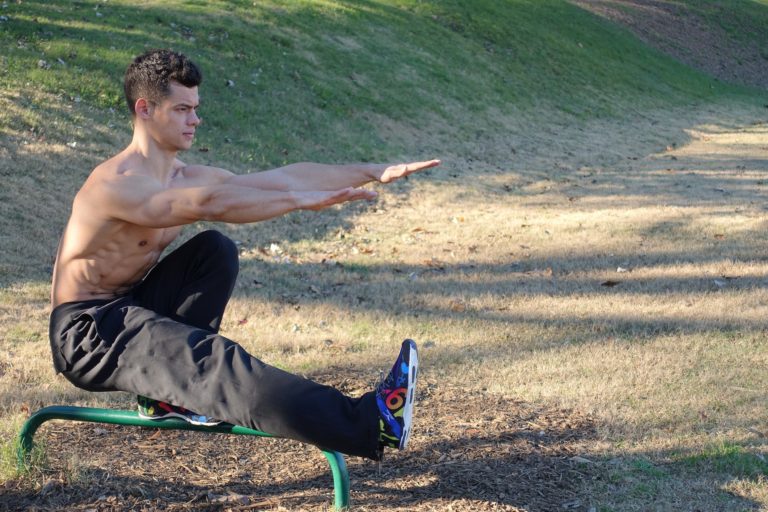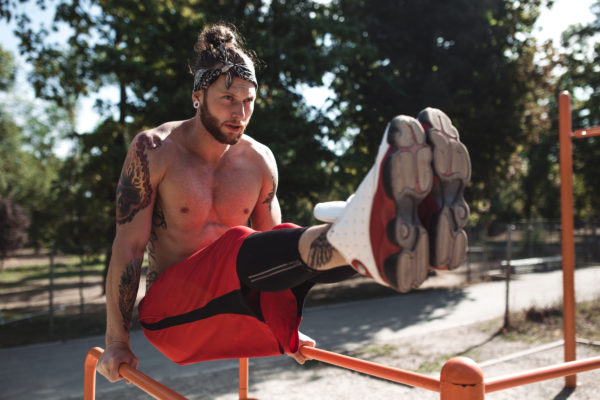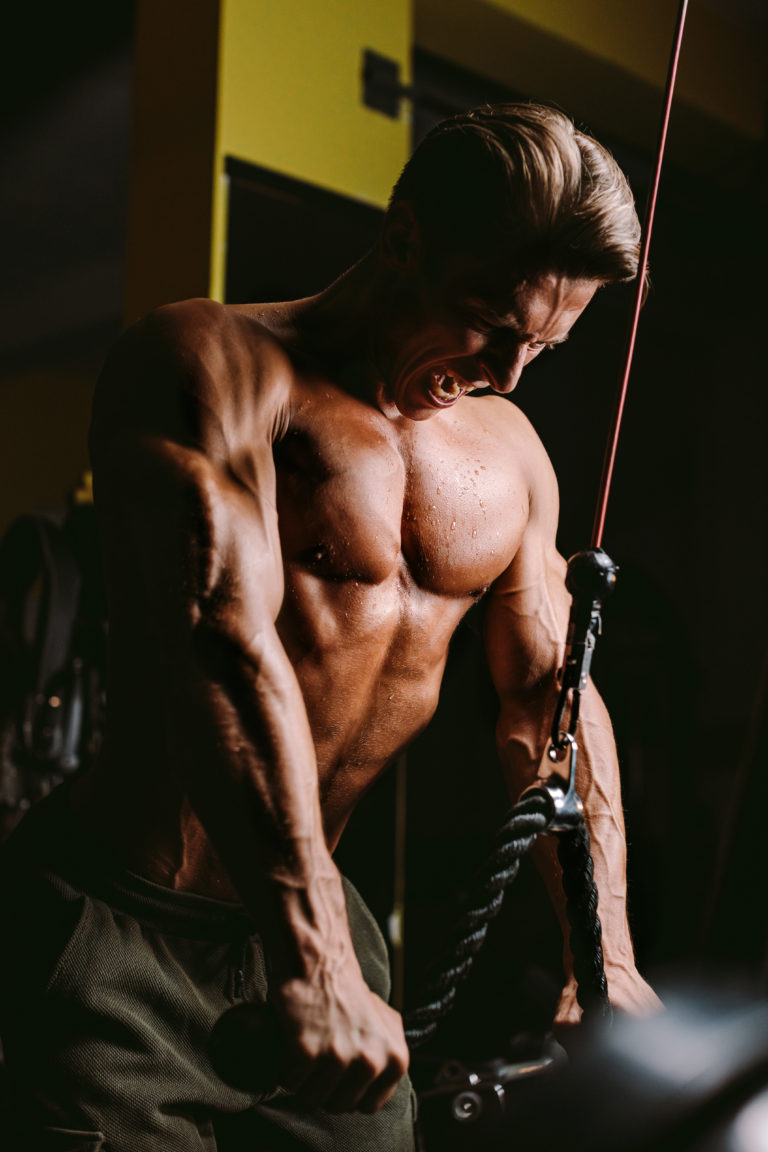
Is Calisthenics Better Than Weight Training?
One of the most common questions I get is regarding the comparison of calisthenics and lifting weights. Is one better than the other? Will weights get me bigger than calisthenics? Will calisthenics get me more shredded?
Whether or not calisthenics is better than weight training all comes down to one simple but very important variable: your goals. Both calisthenics and lifting weights each have their own advantages and disadvantages, so the answer to the question “which is better?” will vary greatly from person to person based on the results they’re trying to achieve.
In this article, I’m going to explain the pros and cons to both styles of training so you understand which is better for you and your goals. But before we dive into the details, let me just explain real quick why I’m qualified to write about this:
- I’m a Certified Personal Trainer (CPT) with the American Council on Exercise
- I’ve been active in fitness as a hobbyist, enthusiast and professional for a cumulative 20 years
- I’ve been practicing progressive calisthenics for 5 years now
- I spent nearly 15 years of my life lifting weights in a gym, building strength and muscle mass
I’m going to share everything I know about the similarities and differences between these two styles of fitness, and this information will not be regurgitated from an exercise science text book – although I could do that, if you want – but instead it will be mostly based on my own training experience.
Calisthenics: Advantages and Disadvantages
A lot of viewers on my YouTube channel have asked me why I abandoned the gym. I get questions like, “what do you have against gyms and lifting weights?”
The truth is that I don’t have anything “against” gyms, weights or machines. It’s fine with me if people want to use gym equipment. I have no qualms with that. But for me, personally? I needed a break from it.

Me rising into a bent-arm handstand on parallettes
I had a realization when I was just about to hit 30 years old. I realized that after nearly 15 years spent lifting weights, I could hardly touch my toes or do a decent backbend. In other words: my mobility was severely lacking.
That’s when progressive calisthenics entered the equation.
When I first started training calisthenics I could only do the basics: push-ups, pull-ups, dips, squats, lunges, leg raises and core exercises. That’s it! Everything else beyond that – such as handstands, back bridges, L-sits and elbow levers – were physically impossible for me thanks to my incredibly poor mobility.
However, as I trained the basic exercises and focused on mastering them, I noticed my mobility naturally improving. This was a slow, gradual process, but it was definitely happening. It required no additional training; simply working on basics was improving my ROM.
Calisthenics Improves Mobility

If you look at any mobility exercises you’ll notice they all have this quality in common: you’re moving your joints through your current full range of motion using only your bodyweight.
You don’t want to add weight to mobility exercises – at least not in the beginning – because the goal is simply to improve your flexibility and then practice moving your joints within that newly achieved range-of-motion.
Sure, some advanced mobility exercises will require adding weight, such as the Jefferson Curl, but the vast majority of mobility work is simply bodyweight movement.
Well, when you perform basic calisthenics exercises, you’re using only your bodyweight, right? And you’re repeating that movement through your current full range-of-motion. Over and over and over.
The repetition of these basic bodyweight exercises allows you to gradually go deeper as you naturally increase your flexibility, same as all the most common mobility exercises.
Take the squat, for example. Let’s say when you start calisthenics you can only squat down until your thighs are just above parallel to the ground. You work on your squats about 3-4 times per week (every other day) for several months.
Since you’re not adding weight, what are some of the things you will do to progress the exercise? (1) slow the tempo, (2) hold the bottom position, (3) make them plyometric by jumping, and (4) go deeper.
As you work on your bodyweight squats and make an effort to go deeper, you will naturally increase your flexibility and mobility. And this same concept will apply to every calisthenics exercise you do regularly.
Further, once you’ve mastered the basics you’ll want to pursue more advanced exercises, each of them requiring focused mobility work:
- Handstand (shoulder & hip mobility)
- L-sit (core compression and hamstring flexibility)
- Back bridge (hyperextension of the back)
- Back lever (shoulder mobility)
- And so on…
It’s pretty clear that everything from the most basic to advanced calisthenics exercises involve improved mobility. That’s a huge advantage compared to lifting weights!
And why is good mobility a huge benefit? You’ll understand once everyone else your age is walking around hunched over and in constant pain while you’re busy playing tag with your grand kids in the backyard.
Calisthenics Is Perfect for Getting Lean

Getting leaner only can help when it comes to calisthenics
When you lift weights, you’re contracting your skeletal muscle to move external weight. That, in my experience, is much different from lifting your own body.
Lots of people will tell you that your body knows no difference between lifting itself and lifting a dumbbell or barbell, but I’ve personally experienced something that says otherwise. Let me explain what I mean.
When I used to lift weights, I remember my hunger being through the roof. I’d lift weights for a good 60-75 minute session and feel ravenous with hunger for the rest of the day. Even for the entire next day, too. It was like subconsciously I wanted my body to grow physically larger from eating in a caloric surplus because it would help me move those external objects easier.
But with calisthenics? It’s different. Obviously, I’m still hungry after a 60-75 minute workout and need to eat to recover, but the hunger isn’t ravenous like it used to be. I’m able to eat a reasonable amount and not cave in to the temptations of eating in excess.
This obviously could be purely psychological (it probably is!) but my point is the same: when using calisthenics as my resistance training, I’m subconsciously focused on keeping lean.
This is most likely a result of knowing I’m lifting my own body and not an external weight. I know subconsciously that if I have less body fat, the exercises I’m performing will be easier.
Coming from a textbook endomorph like myself, that’s extremely valuable. Keep it in mind if you’ve struggled to be lean in the past as well.
Calisthenics Looks More Impressive
This is purely subjective, but from polling others I’ve found most people to be in agreement on this, so I’ve decided to include it as a reason.

Me holding a handstand – the skill that convinced me to start calisthenics
Let me tell you a quick story that sums this up quite well.
Back when I used to lift weights, I was at a local gym and resting between sets on an incline bench. I looked over and saw two guys performing squats by the squat rack:
- One guy was doing barbell squats with 3 plates on each side (315 lbs/143 kg)
- The other guy was holding a 25 lb plate in front of him performing perfect pistol squats
I had seen pistols before online but never in person. As I stared over at the two guys repping away, I found myself far more impressed with the guy doing pistol squats. He had my full attention.
Part of the reason may have been that I could squat 315 lbs myself but couldn’t do a pistol squat, but… honestly? The pistols just looked more badass.
And for myself and most people I’ve talked to, this is the case all around with calisthenics.
Freestanding handstand push-ups? WAY more impressive than heavy military press or incline bench press.
Human flag? WAY more impressive than… uh… whatever the equivalent is for a human flag in weight lifting.
Calisthenics has flare. That’s the bottom line. It’s great for showing off and looking like a fitness master.
Calisthenics Has Its Downsides
Not so fast! Calisthenics isn’t all amazing and perfect fitness mastery like I’m making it sound so far. There are a few downsides.
First off, it’s not the most ideal form of resistance training for putting on mass.
Nope! Contrary to what some people will tell you, the only way to get bigger with bodyweight exercises are to either:
- Do very high volume and rely on sarcoplasmic hypertrophy
- Add weight with a weighted vest
The sarcoplasmic hypertrophy route can work if you want to do hundreds of reps per workout and have a routine of 5 days per week.
The weight vest method is great, but it’s technically not bodyweight exercise anymore. You’re doing bodyweight movements such as dips, push ups, pull ups and squats, but with weight added to you. That’s not pure calisthenics.
This fact about hypertrophy and the requirement of progressive overload – whether by training volume or intensity – is exactly why you see some people doing amazing calisthenics skills but their musculature isn’t very big (Steven Low, author of Overcoming Gravity, is a perfect example of this).
Second, calisthenics is not always equipment-free like it’s touted to be.
Want to do pull ups? You need a pull up bar.
Want do do dips or L-sits? You need parallel bars.

Want to do a human flag? You need a vertical pole or something similar.
Bottom line – there’s still equipment required for a lot of calisthenics.
And third, let’s not forget that it’s far more complex than weight training. Meaning, it’s not as simple as just adding more weight to a bar once you achieve a certain number of reps. Nope. You need to understand physics and anatomy to figure out the next calisthenics progression (or have a trusty coach or program).
Weightlifting: Advantages and Disadvantages
Now that I’ve explained some of the most significant ups and downs of calisthenics, let’s put weightlifting under a microscope and see what it has going for and against it.
While I’m currently training only calisthenics (and weighted calisthenics with a vest), I’m not in any way saying that lifting weights is not a worthwhile form of resistance training. In fact, I think it’s great. Anyone who wants to do it definitely should.
I have very fond memories of all my time spent in gyms between the ages 15 and 30. And there are definitely several things about it that I miss. In fact, the only reasons why I stopped going to the gym and lifting were:
- Lack of time to get to a gym
- Decreased mobility from doing the same exercises for years
- Boredom and desire to try something new
So, keep in mind I’m coming at this from a rather unbiased approach.
Lifting Weights Is Perfect For Progressive Overload
I think this is the biggest and most obvious thing that weightlifting has going for it.
Whenever someone asks, “How do I build more muscle mass?” the best answer is always going to be, “lift some weights.”

Hell, even when people ask me that but are dedicated to calisthenics, my answer to them is to add weight to their calisthenics exercises with a vest or backpack.
Why? Well, it boils down to two things.
In order to grow your mass physically larger, you need two essential ingredients:
- Progressive overload (the gradual increase of intensity for an exercise)
- A caloric surplus
And guess what. With weight lifting, ingredient #1 (progressive overload) couldn’t be any easier. Just add a small increment of weight from workout to workout.
Lifting Weights Is Simpler Than Calisthenics (In A Good Way)
I know some folks might say that being “simple” isn’t a good thing, but when it comes to being a newbie in the world of fitness, it’s easy to get overwhelmed. That’s why the simplicity of dumbbell and barbell based exercises can be handy.
If a client came to me and said, “I don’t care how we accomplish it, but I want a big upper chest and wide shoulders,” I’d undoubtedly get them on a weight lifting regimen. The reason why? The simplicity of the exercises would get them there FASTER.
Incline bench (or dumbbell) press? It’s a simple movement that anyone can learn properly in a single session with light weight. But the calisthenics opposite, decline push-ups? It takes a bit more work.
How about for those wide shoulders? I’d have them doing dumbbell lateral raises, an exercise that’s extremely difficult (dare I say impossible) to emulate perfectly with bodyweight alone.
And that leads me to the next point about weight lifting…
There Are Weight Lifting Exercises You Can’t Duplicate With Calisthenics
Dumbbell lateral raises are probably the shining example of this, so I’ll focus on that for now.

Try to duplicate the sheer effectiveness of dumbbell lateral raises in terms of isolating the medial deltoid head using only calisthenics.
It’s hard, right?
How would you even do it? Perhaps in a side-lying position, pressing your outstretched arm hard against the ground beneath you to provide an isometric contraction? But your bodyweight would be WAY too heavy for the medial deltoid alone, so maybe instead you’d stand by a wall and press isometrically against the wall?
I’ve tried both those exercise before, believe it or not, and although they can work (somewhat) they just don’t compare to having a light set of dumbbells for lateral raises.
A cheaper alternative to dumbbells would be to use resistance bands that you stand on and perform lateral raises, but again, that’s not true bodyweight exercise.
And that’s just one example. Nearly any isolation exercise – from bicep curls to hamstring curls to tricep extensions – are not easy to duplicate in a calisthenics fashion.
For that reason, one HUGE advantage to lifting weights is the selection of unique isolation exercises that are possible only with dumbbells and barbells. This is especially beneficial to those focused on physique goals.
The Downsides to Weight Lifting
Same as calisthenics, lifting has some similar disadvantages that are worth mentioning. Namely:
- Unavoidable reliance on specialized equipment
- Lack of freedom in movements
- Higher risk of damage to joints in heavy lifting
- Completely neglects mobility advancement, unless specifically trained
The first bullet is pretty clear: you absolutely need equipment to lift weights. It’s not like calisthenics where you can get in a great workout with just your body and gravity. This is a big downside, especially when gyms are closed (does COVID-19 ring a bell?)
Lack of freedom in movements refers to the restrictive nature of weight lifting exercises. Weight lifting encourages the same, repetitive movement over and over, with more weight added over time. In comparison, calisthenics encourages progressive development of movements which gradually increase ROM and alter the exercise completely, leading to nearly constant development of new neurological pathways.
The third bullet is in regard to risk of injury when lifting heavy. There’s no denying that if you get into heavy weight lifting (and I mean heavy), no matter how careful you are, you are increasing risk of long-term injury on your joints, especially if you try to push more weight too quickly.
And lastly, unless you specifically add mobility training to your program, weight lifting does virtually nothing to naturally increase your mobility. This is in contrast to bodyweight exercises, like discussed previously in this article, which bear resemblance to mobility exercises and help increase ROM by nature.
So Which Is Better For You? Calisthenics Or Weights?
I hope this article outlined all the pros and cons you were wondering about in relation to these two awesome forms of resistance training.
Again, I tried my best to come at this from an unbiased perspective. I honestly believe that both weight lifting and bodyweight exercise have their place in any fitness program. And although I’ve been solely focused on calisthenics in the last 5 years or so, I’m long overdue to get back into weight lifting. It will only compliment by calisthenics training.
Perhaps your current goals will lend well to only one of these forms of training. Or perhaps you could benefit from a combintaiont of the two.
No matter which approach you take – calisthenics, weight lifting, or both – just remember the most important thing to do…
TRAIN HARD AND EAT SMART.
Share This Story, Choose Your Platform!